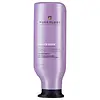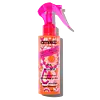What's inside
What's inside
 Key Ingredients
Key Ingredients

 Benefits
Benefits

 Concerns
Concerns

 Ingredients Side-by-side
Ingredients Side-by-side

Water
Skin ConditioningCetearyl Alcohol
EmollientBehentrimonium Chloride
PreservativeIsopropyl Myristate
EmollientCetyl Esters
EmollientIsopropyl Alcohol
SolventMentha Arvensis Leaf Oil
MaskingPhenoxyethanol
PreservativeParfum
MaskingPolyquaternium-37
Glycine Soja Oil
EmollientPropylene Glycol Dicaprylate/Dicaprate
EmollientDisodium EDTA
Glycerin
HumectantButylene Glycol
HumectantMenthol
MaskingLimonene
PerfumingTocopherol
AntioxidantPPG-1 Trideceth-6
Skin ConditioningChlorhexidine Dihydrochloride
AntimicrobialHydroxypropyltrimonium Hydrolyzed Wheat Protein
Skin ConditioningHelianthus Annuus Seed Extract
Skin ConditioningWheat Amino Acids
Skin ConditioningSodium Chloride
MaskingBenzophenone-4
UV AbsorberLinalool
PerfumingEucalyptus Globulus Leaf Extract
PerfumingAscorbic Acid
AntioxidantMelanin
Skin ProtectingPotassium Sorbate
PreservativePentylene Glycol
Skin ConditioningEthylhexylglycerin
Skin ConditioningWater, Cetearyl Alcohol, Behentrimonium Chloride, Isopropyl Myristate, Cetyl Esters, Isopropyl Alcohol, Mentha Arvensis Leaf Oil, Phenoxyethanol, Parfum, Polyquaternium-37, Glycine Soja Oil, Propylene Glycol Dicaprylate/Dicaprate, Disodium EDTA, Glycerin, Butylene Glycol, Menthol, Limonene, Tocopherol, PPG-1 Trideceth-6, Chlorhexidine Dihydrochloride, Hydroxypropyltrimonium Hydrolyzed Wheat Protein, Helianthus Annuus Seed Extract, Wheat Amino Acids, Sodium Chloride, Benzophenone-4, Linalool, Eucalyptus Globulus Leaf Extract, Ascorbic Acid, Melanin, Potassium Sorbate, Pentylene Glycol, Ethylhexylglycerin
 Reviews
Reviews

Alternatives
Ingredients Explained
These ingredients are found in both products.
Ingredients higher up in an ingredient list are typically present in a larger amount.
Parfum is a catch-all term for an ingredient or more that is used to give a scent to products.
Also called "fragrance", this ingredient can be a blend of hundreds of chemicals or plant oils. This means every product with "fragrance" or "parfum" in the ingredients list is a different mixture.
For instance, Habanolide is a proprietary trade name for a specific aroma chemical. When used as a fragrance ingredient in cosmetics, most aroma chemicals fall under the broad labeling category of “FRAGRANCE” or “PARFUM” according to EU and US regulations.
The term 'parfum' or 'fragrance' is not regulated in many countries. In many cases, it is up to the brand to define this term.
For instance, many brands choose to label themselves as "fragrance-free" because they are not using synthetic fragrances. However, their products may still contain ingredients such as essential oils that are considered a fragrance by INCI standards.
One example is Calendula flower extract. Calendula is an essential oil that still imparts a scent or 'fragrance'.
Depending on the blend, the ingredients in the mixture can cause allergies and sensitivities on the skin. Some ingredients that are known EU allergens include linalool and citronellol.
Parfum can also be used to mask or cover an unpleasant scent.
The bottom line is: not all fragrances/parfum/ingredients are created equally. If you are worried about fragrances, we recommend taking a closer look at an ingredient. And of course, we always recommend speaking with a professional.
Learn more about Parfum